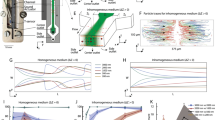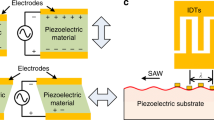Abstract
Acoustophoresis has gained increasing attention as a gentle, non-contact, and high-throughput cell and particle separation technique. It is conveniently used to isolate and enrich particles that are greater than 2 μm; however, its use in manipulating particles smaller than 2 μm is limited. In this work, we present an alternative way of using acoustic forces to manipulate sub-micrometer particles in continuous flow fashion. It has been shown that acoustic forces can be employed to relocate parallel laminar flow streams of two impedance-mismatched fluids. We demonstrate the separation of sub-micron particles from micron particles by the combination of acoustophoresis and acoustic fluid relocation. The micron particles are focused into the middle of the flow channel via primary acoustic forces while sub-micron particles are moved to the side via drag forces created by the relocating fluid. We demonstrate the proof of the concept using binary mixtures of particles comprised of sub-micron/micron particles, micron/micron particles, and bovine red blood cells with E. coli. The efficiency of the particle enrichment is determined via flow cytometry analysis of the collected streams. This study demonstrates that by combining acoustic fluid relocation with acoustophoresis, sub-micron particles can be effectively separated from micron particles at high flow rates and it can be further implemented to separate binary mixtures of micron particles if the volumetric ratio of two particles is greater than 10 and the larger particle diameter is about 10 μm. The combined method is more appropriate to use than acoustophoresis in situations where acoustic streaming and differences in acoustic impedance of fluids can be of concern.

In the presence of a resonance acoustic field, the clean high-density fluid (dark gray) and the low-density sample fluid are relocated. During this process, E. coli are separated from the red blood cells (RBCs).







Similar content being viewed by others
References
Ohlsson P, Evander M, Petersson K, Mellhammar L, Lehmusvuori A, Karhunen U, et al. Integrated acoustic separation, enrichment, and microchip polymerase chain reaction detection of bacteria from blood for rapid sepsis diagnostics. Anal Chem. 2016;88(19):9403–11.
Chen C, Skog J, Hsu C-H, Lessard RT, Balaj L, Wurdinger T, et al. Microfluidic isolation and transcriptome analysis of serum microvesicles. Lab Chip. 2010;10(4):505–11.
Morgan H, Hughes MP, Green NG. Separation of submicron bioparticles by dielectrophoresis. Biophys J. 1999;77(1):516–25.
Liu KJ, Brock MV, Shih I-M, Wang T-H. Decoding circulating nucleic acids in human serum using microfluidic single molecule spectroscopy. J Am Chem Soc. 2010;132(16):5793–8.
Lamparski HG, Metha-Damani A, Yao J-Y, Patel S, Hsu D-H, Ruegg C, et al. Production and characterization of clinical grade exosomes derived from dendritic cells. J Immunol Methods. 2002;270(2):211–26.
Tauro BJ, Greening DW, Mathias RA, Ji H, Mathivanan S, Scott AM, et al. Comparison of ultracentrifugation, density gradient separation, and immunoaffinity capture methods for isolating human colon cancer cell line LIM1863-derived exosomes. Methods. 2012;56(2):293–304.
Akbulut O, Mace CR, Martinez RV, Kumar AA, Nie Z, Patton MR, et al. Separation of nanoparticles in aqueous multiphase systems through centrifugation. Nano Lett. 2012;12(8):4060–4.
Raddatz MSL, Dolf A, Endl E, Knolle P, Famulok M, Mayer G. Enrichment of cell-targeting and population-specific aptamers by fluorescence-activated cell sorting. Angew Chem. 2008;120(28):5268–71.
van der Pol E, Böing AN, Harrison P, Sturk A, Nieuwland R. Classification, functions, and clinical relevance of extracellular vesicles. Pharmacol Rev. 2012;64(3):676–705.
Shields CW IV, Reyes CD, López GP. Microfluidic cell sorting: a review of the advances in the separation of cells from debulking to rare cell isolation. Lab Chip. 2015;15(5):1230–49.
Di Carlo D, Irimia D, Tompkins RG, Toner M. Continuous inertial focusing, ordering, and separation of particles in microchannels. Proc Natl Acad Sci U S A. 2007;104(48):18892–7.
Petersson F, Åberg L, Swärd-Nilsson A-M, Laurell T. Free flow acoustophoresis: microfluidic-based mode of particle and cell separation. Anal Chem. 2007;79(14):5117–23.
Antfolk M, Laurell T. Continuous flow microfluidic separation and processing of rare cells and bioparticles found in blood–a review. Anal Chim Acta. 2017;965:9–35.
Gascoyne PRC, Noshari J, Anderson TJ, Becker FF. Isolation of rare cells from cell mixtures by dielectrophoresis. Electrophoresis. 2009;30(8):1388–98.
Didar TF, Li K, Veres T, Tabrizian M. Separation of rare oligodendrocyte progenitor cells from brain using a high-throughput multilayer thermoplastic-based microfluidic device. Biomaterials. 2013;34(22):5588–93.
Augustsson P, Magnusson C, Nordin M, Lilja H, Laurell T. Microfluidic, label-free enrichment of prostate cancer cells in blood based on acoustophoresis. Anal Chem. 2012;84(18):7954–62.
Gor'kov L. On the forces acting on a small particle in an acoustical field in an ideal fluid. Sov Phys Dokl. 1962;6:773–5.
Suthanthiraraj PPA, Piyasena ME, Woods TA, Naivar MA, Lόpez GP, Graves SW. One-dimensional acoustic standing waves in rectangular channels for flow cytometry. Methods. 2012;57(3):259–71.
Augustsson P, Persson J, Ekstrom S, Ohlin M, Laurell T. Decomplexing biofluids using microchip based acoustophoresis. Lab Chip. 2009;9(6):810–8.
Deshmukh S, Brzozka Z, Laurell T, Augustsson P. Acoustic radiation forces at liquid interfaces impact the performance of acoustophoresis. Lab Chip. 2014;14(17):3394–400.
Petersson F, Nilsson A, Jönsson H, Laurell T. Carrier medium exchange through ultrasonic particle switching in microfluidic channels. Anal Chem. 2005;77(5):1216–21.
Barnkob R, Augustsson P, Laurell T, Bruus H. Acoustic radiation-and streaming-induced microparticle velocities determined by microparticle image velocimetry in an ultrasound symmetry plane. Phys Rev E Stat Nonlinear Soft Matter Phys. 2012;86(5):056307.
Glynne-Jones P, Hill M. Acoustofluidics 23: acoustic manipulation combined with other force fields. Lab Chip. 2013;13(6):1003–10.
Leibacher I, Reichert P, Dual J. Microfluidic droplet handling by bulk acoustic wave (BAW) acoustophoresis. Lab Chip. 2015;15(13):2896–905.
Antfolk M, Muller PB, Augustsson P, Bruus H, Laurell T. Focusing of sub-micrometer particles and bacteria enabled by two-dimensional acoustophoresis. Lab Chip. 2014;14(15):2791–9.
Destgeer G, Ha BH, Jung JH, Sung HJ. Submicron separation of microspheres via travelling surface acoustic waves. Lab Chip. 2014;14(24):4665–72.
Augustsson P, Karlsen JT, Su HW, Bruus H, Voldman J. Iso-acoustic focusing of cells for size-insensitive acousto-mechanical phenotyping. Nat Commun. 2016;7:11556.
Wu M, Ouyang Y, Wang Z, Zhang R, Huang P-H, Chen C, et al. Isolation of exosomes from whole blood by integrating acoustics and microfluidics. Proc Natl Acad Sci U S A. 2017;114(40):10584–9.
Sixing L, Fen M, Hunter B, Craig EC, Xiangqun Z, Tony Jun H. Acoustofluidic bacteria separation. J Micromech Microeng. 2017;27(1):015031.
Evander M, Johansson L, Lilliehorn T, Piskur J, Lindvall M, Johansson S, et al. Noninvasive acoustic cell trapping in a microfluidic perfusion system for online bioassays. Anal Chem. 2007;79(7):2984–91.
Nilsson J, Evander M, Hammarström B, Laurell T. Review of cell and particle trapping in microfluidic systems. Anal Chim Acta. 2009;649(2):141–57.
Lenshof A, Evander M, Laurell T, Nilsson J. Acoustofluidics 5: building microfluidic acoustic resonators. Lab Chip. 2012;12(4):684–95.
Piyasena ME, Austin Suthanthiraraj PP, Applegate RW Jr, Goumas AM, Woods TA, López GP, et al. Multinode acoustic focusing for parallel flow cytometry. Anal Chem. 2012;84(4):1831–9.
Piyasena ME, Graves SW. The intersection of flow cytometry with microfluidics and microfabrication. Lab Chip. 2014;14(6):1044–59.
Petersson F, Nilsson A, Holm C, Jönsson H, Laurell T. Separation of lipids from blood utilizing ultrasonic standing waves in microfluidic channels. Analyst. 2004;129(10):938–43.
Ferraz N, Hong J, Karlsson Ott M. Procoagulant behavior and platelet microparticle generation on nanoporous alumina. J Biomater Appl. 2010;24(8):675–92.
Gautam GP, Burger T, Wilcox A, Cumbo MJ, Graves SW, Piyasena ME. Simple and inexpensive micromachined aluminum microfluidic devices for acoustic focusing of particles and cells. Anal Bioanal Chem. 2018;410(14):3385–94.
Johansson L, Johansson S, Nikolajeff F, Thorslund S. Effective mixing of laminar flows at a density interface by an integrated ultrasonic transducer. Lab Chip. 2009;9(2):297–304.
Weigl BH, Holl MR, Schutte D, Brody JP, Yager P. Diffusion-based optical chemical detection in silicon flow structures. Proceedings of the μTAS; Nov 19–22, 1996. Basel, Switzerland p. 174–84.
Weigl BH, Yager P. Microfluidic diffusion-based separation and detection. Science. 1999;283(5400):346–7.
Funding
Research reported in this publication was supported by an Institutional Development Award (IDeA) from the National Institute of General Medical Sciences of the National Institutes of Health under grant number P20GM103451. This work was performed, in part, at the Center for Integrated Nanotechnologies, an Office of Science User Facility operated for the U.S. Department of Energy (DOE) Office of Science by Los Alamos National Laboratory (Contract DE-AC52-06NA25396) and Sandia National Laboratories (Contract DE-AC04-94AL85000).
Author information
Authors and Affiliations
Corresponding author
Ethics declarations
Conflict of interest
Gayatri P. Gautam and Menake E. Piyasena declare that they have filed a patent application on this technology that uses principles discussed here. Rubi Gurung and Frank A. Fencl declare no competing interests.
Electronic supplementary material
ESM 1
(PDF 510 kb)
Rights and permissions
About this article
Cite this article
Gautam, G.P., Gurung, R., Fencl, F.A. et al. Separation of sub-micron particles from micron particles using acoustic fluid relocation combined with acoustophoresis. Anal Bioanal Chem 410, 6561–6571 (2018). https://doi.org/10.1007/s00216-018-1261-x
Received:
Revised:
Accepted:
Published:
Issue Date:
DOI: https://doi.org/10.1007/s00216-018-1261-x




